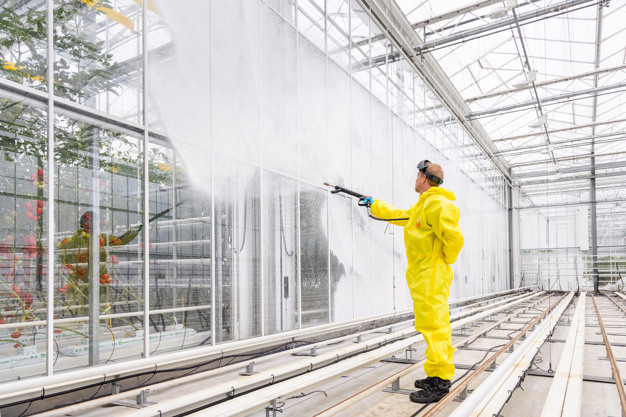After years of successfully avoiding the Tomato Brown Rugose Fruit Virus (ToBRFV), Australia has now reported its first known cases, with two cultivation facilities testing positive for the virus. It marks the first known incidence of this virus in Australia, which until now had managed to remain virus-free. Jasper Verhoeven, hygiene specialist with Royal Brinkman, sheds light on what growers can do to protect their crops from this emerging threat. With their concept HortiHygienz, the company has focused on creating a concept to help growers deal with optimizing business hygiene.

Miraculous
According to Jasper, Australia's ability to stave off ToBRFV until now was nothing short of miraculous – even though Australia is notorious for its biosecurity controls, which are at an extremely high level, and the long shutdown during the pandemic. "But still, it's almost remarkable that the virus hadn't reached Australia earlier," he notes. "In recent years, virus particles have been widely spread across the globe. Australia and New Zealand are relatively isolated with limited traffic. This may have contributed to the absence of infections up until now." He emphasizes that limited movement, particularly during the COVID-19 pandemic, played a role in keeping the virus at bay. He is referring to both the traffic of people and goods. "If you look at Europe, but also Canada, or America, you see that both people and products are moving around. Fresh products are also im- and exported and spread out." These are all ways in which the virus particles can spread, especially since the virus can remain present for a long time and can be found in many places.
Infection
Jasper explains that the virus does not cause infection simply by being present. For an infection to occur, the virus must gain access to the plant, usually through a wound caused by tools or handling. "When growers prune or handle plants, small wounds are created, providing an entry point for the virus," he says. Similarly, the presence of the virus in water does not automatically result in contamination. "If the plant's roots are weakened by pathogens like pythium or fusarium, the virus can penetrate. As long as the virus particles continue to circulate, they will eventually find a way in."
The discovery of ToBRFV in the Northern Adelaide Plains has triggered a national response aimed at containing the outbreak and mitigating its effects. The Department of Primary Industries and Regions (PIRSA) is working closely with the affected businesses, implementing quarantine measures on the properties. An incident management team has been formed to trace connections between the two properties and any other potential sites of contamination.
Northern Adelaide Plains
Northern Adelaide Plains is located near Adelaide, which is the capital city of South Australia, and is the fifth-largest capital city in Australia. The region is home to a thriving horticulture industry that lies immediately north of the Adelaide metropolitan region. It produces approximately 200,000 tonnes of fresh produce and over $300 million in farm gate value annually. Undercover cropping has been increasingly utilized on the Adelaide Plains in recent years. The region is now well recognized as the largest protected cropping region in the Southern Hemisphere with over 1,000 hectares of greenhouse production, and continues to expand by 100 hectares per year.
Jasper highlights the risks associated with the clustering of agricultural activities in specific regions. "Globally, we see the agricultural sector clustering in certain areas, often due to favorable coastal climates or the availability of knowledge and resources," he explains.
While this concentration of activities can be beneficial, it also increases the risk of disease outbreaks, as seen with the recent ToBRFV detection. Earlier this year, the region was also hit by a fruit fly outbreak, underscoring the vulnerability of such concentrated agricultural zones. In March of 2024, an outbreak was declared in Adelaide's northern suburbs after six flies were found in traps as part of regular surveillance activities.
Fear in the industry
Whether the ToBRFV infection occurred in greenhouse facilities or open fields is not confirmed by official sources yet. Jasper notes that this is still very recent news, and researchers are being cautious not to spread misinformation. "Fear in the sector can play a significant role, especially when dealing with the first detection of a virus in a region. There's often a tendency not to share information, in fear of having to halt the cultivation. However, as growers and industry-related bodies gain more experience and knowledge, they become more open and proactive in addressing virus-related issues."
Given the current situation, Jasper advises Australian growers to take immediate action to strengthen their biosecurity measures. "In comparison to other regions where the virus has been present for longer, Australia and New Zealand's protocols are often not yet fully developed. While growers may temporarily close their facilities, this cannot last indefinitely. Now is the time to establish robust protocols and streamline the process of reintroducing resources. General cleaning and disinfection are well-known practices, but a comprehensive protocol goes beyond that."
Insurance policy
Jasper likens these protocols to an insurance policy. "Implementing such measures requires time and money—this is your premium. But if contamination occurs, you can scale up your response much more easily. That's far better than trying to develop a protocol under the pressure of an outbreak." He adds that the extent of the measures taken will depend on the type of business. "Breeding companies might go for a gold-standard protocol, while others may find basic disinfection sufficient. The key is for growers to think about these issues and take action, with our support."
One thing is certain, according to Jasper: the virus is here to stay. Even if all greenhouses were cleaned, it's not realistic to expect the virus to be removed from open-field cultivation. "There are processes to eliminate the virus from soil, such as composting or steaming, but realistically, these are not feasible on a large scale in open fields. Chemical treatments might be an option, but they're not desirable either."
Removing the virus from an existing crop is not possible. "I've heard reports about it, but there's no proven playbook. Maybe it will be possible in the future?" he wonders, adding it is possible to help plants grow through the virus by making sure they have the best possible circumstances to grow: "Fertilizers, biostimulants, climate, plant management, healthy water, hygienic labor, etc. All these factors could result in a crop that's strong enough – but it requires applying the right actions at the right time. If you're too late, it's over. Otherwise, the only way to eliminate the virus from a plant is through destruction."
Even in a greenhouse, keeping out the virus, or avoiding reinfection after the crop rotation, proves to be difficult. "Otherwise, we wouldn't still be dealing with CGMV, but we are." Dealing with the fact viruses exist is what growers have to do. Virus particles can always find a way to linger, and preventing it from entering takes effort."
As more and more resistant varieties become available, this is also something that will help growers deal with the virus – but still, many of them opt for a traditional, non-resistant variety, as this better matches their cultivation or marketing goals.
Crop rotation
Australia's traditional growing season has just begun, which presents both challenges and opportunities. On one hand, an outbreak at the start of the season can have severe consequences for crops. On the other hand, this timing allows growers to prepare thoroughly for the upcoming crop rotation, a critical step in resetting the growing environment. "Fear is driving decisions right now, but it's not the best advisor," Jasper cautions. "The early season offers a chance to prepare well for the crop rotation. If this is neglected, virus particles can build up, increasing the likelihood of an infectious outbreak." The focus is on lowering disease pressure and minimizing risks. "Tools to do so are resistant varieties, technologies to optimize water quality, and the right combination of agents to clean and disinfect all contamination sources, including on people, utilities, and structures. After a thorough cleaning, starting as clean as possible reduces the risk of contamination. Prevention is key."
 For more information:
For more information:
Royal Brinkman
[email protected]
www.royalbrinkman.com
www.royalbrinkman.com/hortihygienz
